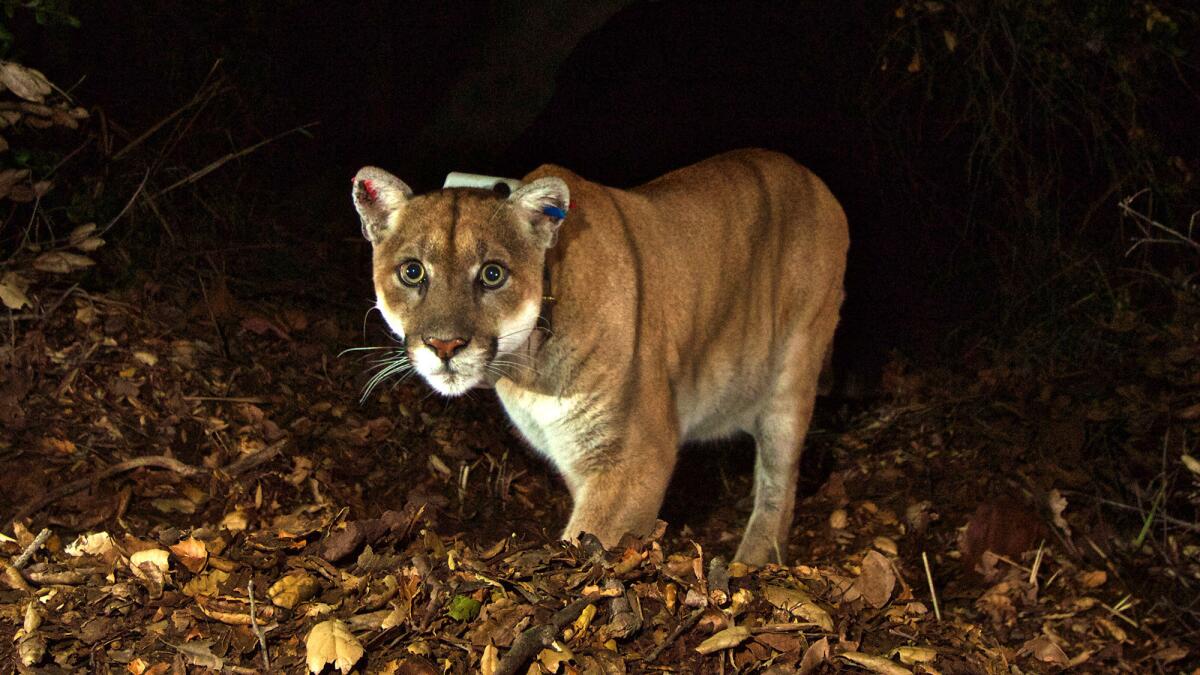Mourning ‘L.A.’s coolest cat’ and celebrating how P-22 changed our relationship with nature

- Share via
For a decade, he was perhaps L.A.’s wildest and most elusive resident. So when word spread Saturday that the mountain lion P-22 was gone, his city swelled with sadness and admiration.
A congressman called him a “beloved mascot.” The biologist who helped identify him dubbed him an “iconic ambassador for wildlife.” An everyday citizen tweeted that the 12-year-old bachelor with the mesmerizing eyes clearly had been “L.A.’s coolest cat.”
The city’s lion king had been slowed by a series of ailments and was likely hit by a car in recent weeks, a situation that landed him in increasingly precarious interactions with humans and their pets, before he was trapped Monday by wildlife officials. They euthanized him Saturday morning.
“Although I wished so desperately he could be returned to the wild or live out his days in a sanctuary, the decision to euthanize our beloved P-22 is the right one,” wrote Beth Pratt, a National Wildlife Federation official who had become one of the mountain lion’s most vocal advocates. “With these health issues, there could be no peaceful retirement, only some managed-care existence where we prolonged his suffering — not for his benefit but for ours.”
Gov. Gavin Newsom, whose father was a founder of the Mountain Lion Foundation and championed protections for the species, said in a statement that P-22’s survival “on an island of wilderness in the heart of Los Angeles captivated people around the world and revitalized efforts to protect our diverse native species and ecosystems.”
The governor noted that P-22’s predicament — isolated by freeways in the relatively cramped environs around Griffith Park — had helped galvanize state officials to try to prevent other creatures from being cornered by man-made impediments. The result will be the world’s largest “wildlife overpass,” under construction over the 101 Freeway near Liberty Canyon in Agoura Hills, to provide safe passage for mountain lions and other animals.
While messages of sadness came from around the city and the world, to people who frequent Griffith Park, the nine-square-mile urban oasis where the puma made his first appearance in 2012, the loss of P-22 felt particularly intimate.
“We loved him,” said Wayne V., a jazz musician and regular hiker in the park, who preferred not to give his last name. “It was not just him but the idea that he was up here. That will be missed. Bless his heart.”
Joan Fradkin, a consultant on conservation issues who lived in nearby Beachwood Canyon before moving to Santa Barbara, said P-22’s saga should remind humans about the value of coexisting with their fellow beings.
“The lesson I would take away is learn to live side by side with the creatures that have been there before you and are now here with you,” said Fradkin. “After all, they were here first. And we are now in their space.”
Luis Caballero of Montebello rode his bicycle through the park with his Pomeranian-Shih Tzu mix, Rex, in his backpack. He recalled attending the fourth annual P-22 Day Festival in October in the park (“Peace. Love. P-22,” posters said) to promote efforts to protect the endangered species in Southern California.
Caballero said his dog had been frightened by merely the lifesize posters of P-22. While Caballero, who works for a kombucha manufacturer, was saddened by the death, he worried that the mountain lion could have met a more inhumane end if the recent attacks on pets had advanced to humans.
“So this is hard,” Caballero said. “But right now, it’s probably for the best.”
Biologists believe P-22 entered the park in February 2012, after a journey of 20 miles or so from farther west in the Santa Monica Mountains. A survey of wildlife in the park, using remote cameras, picked up an obscure image of the puma sometime shortly after that. P-22 was then about 2 years old.
That attracted the attention of Steve Winter, renowned for photographing big cats in jungles and savannas around the world. Winter became possessed by the idea of depicting the plight of an urban cat by capturing his image at night, against the backdrop of city lights.
Winter and his crew set up several cameras, remotely triggered by infrared beams and secured in locked steel boxes. It took 11 months to nab a photo of P-22. The shot shows the puma, standing hearty and regal atop a brown patch of earth that seems to float above the lights of L.A. The photo ran in October 2013 on Page 1 of The Times, making the mountain lion famous. Another Winter photo, taken four months later with the lighted Hollywood sign as a backdrop, cemented P-22’s mystique.
On Saturday, Winter was fielding calls from the media and still marveling at a project he called “a miracle from the very beginning.”
“He’s gone now, but his spirit is not gone at all,” said Winter, who spoke to The Times from his home in Hoboken, N.J. He suggested that the charismatic cat would inspire more wildlife corridors and preservation of open spaces.
“The most fitting memorial to P-22 will be to carry his story forward,” he said, “so mountain lions will be able to bounce back and thrive.”
More to Read
Sign up for Essential California
The most important California stories and recommendations in your inbox every morning.
You may occasionally receive promotional content from the Los Angeles Times.











